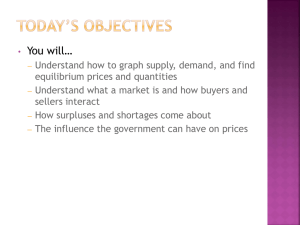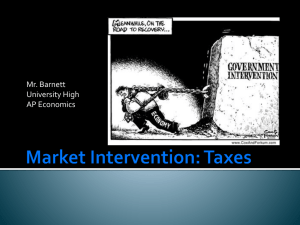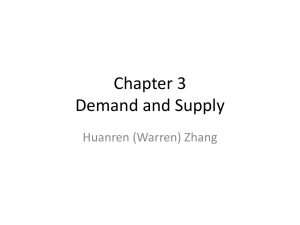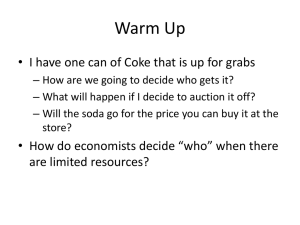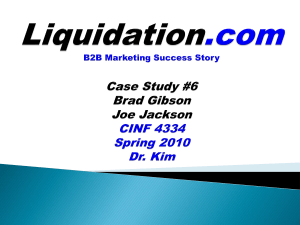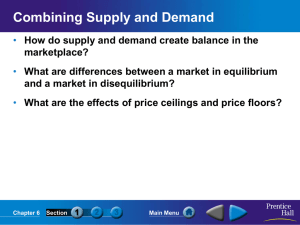Class 6 notes
advertisement
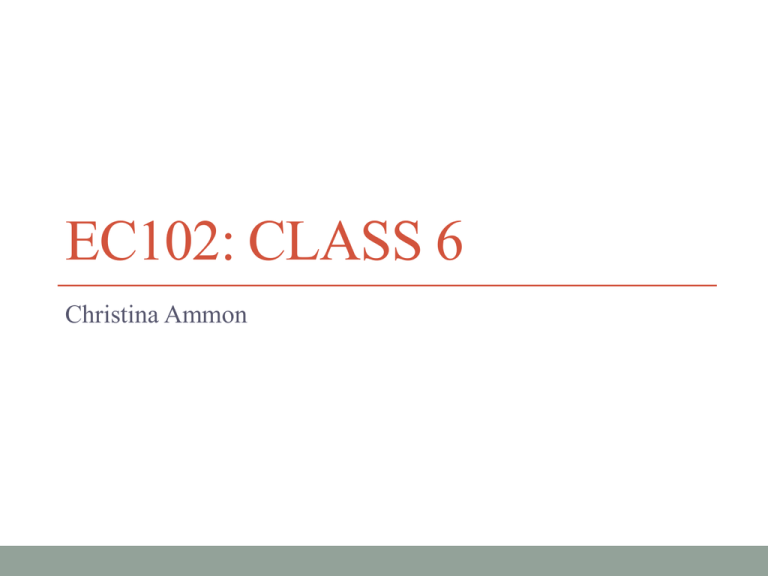
EC102: CLASS 6 Christina Ammon Overview Will go through one question today as an example of what to do + common mistakes Will go through one more next week Moodle Quiz 6 Common Mistakes/Tips Expected to write half a page for each 5 point sub-question Makes sure you answer the question! • It might seem an obvious conclusion to what you said before but still need to write it! Graphs • Include them whenever possible • Use one for every subquestion • Label your graphs! Don’t just describe what happens but why things happen! • i.e. the equilibrium changes is not enough • Why does the equilibrium change? Why is the old allocation no longer an equilibrium Common Mistakes/Tips II Make sure your writing is legible Try to use more “technical” language • It will shorten your answers and give you more points • E.g. when relative prices change the budget constraint pivots or rotates Try to be very exact with your descriptions E.g. demand increases is not the same as the demand curve shifts • • The equivalent would be: demand increases for every price level Point out when it’s a shift and when we move along the demand curve. Market clearing is not the same as an equilibrium in general! Example question: 2f Use a diagram to show the new equilibrium in the coffee market after the increase in the price of tea and compare it with the equilibrium before the increase in the price of tea. Graph: One Answer As coffee and tea are substitutes, the increase in the price of tea increases the demand of coffee As a result, prices go up and quantities demanded increase. At the new equilibrium, prices are higher and quantities have increased. Better answer As coffee and tea are substitutes, the increase in the price of tea means that consumers substitute away from tea and towards coffee. This increases the demand for coffee for any given price. Thus the demand curve shifts out. Now, e1, the equilibrium in the market before the change in the price of tea, is no longer an equilibrium, as at p1 there is excess demand. The excess demand creates a competition for coffee among consumers, which pushes up prices. The increase in prices decreases demand and simultaneously increases supply as producers are willing to supply a larger quantity for a higher price and we move along the supply curve This continues until supply equals demand again At the new equilibrium, of P2 and Q2, prices are higher and quantities consumed have increased compared to the old equilibrium Perfect Competition Assumptions • Many, small buyers • Many, small sellers • Output is homogeneous • Perfect information • There are no barriers to entry What does that imply about the equilibrium • Sellers are price takers • Buyers are price takers • Profits are zero in the long run • Sellers do not behave strategically Perfect Competition Price taking • Sellers or buyers have no market power • i.e. sellers cannot influence the price at which they are able to sell their output and buyers cannot influence the price at which they buy the goods Strategic Behaviour • A supplier does not behave “strategically” when it does not anticipate any reaction by rival suppliers when it chooses its own actions Question 1 The can industry does not fit the conditions of a perfectly competitive market structure because: • • • • Products are homogeneous There are a lot of producers Producers are price-takers Producers behave strategically Question 2 The demand of a good is said to be perfectly elastic if its demand curve: • • • • Slopes downwards Slopes upwards Is vertical Is horizontal tion&3 Question 3 sM is supply by Mash Farm, sS is supply by Spuds Suppliers and SSR is market supply. When the price of potatoes is 300, the quantities supplied by Mash Farm, Spuds Suppliers and the market are respectively: 50, 100 and 150 40, 75 and 150 40, 75 and 115 40, 75 and 100 tion&3 Question 4 When the price of potatoes rises from 300 to 400, the elasticity of market supply is: • 105/115 • 115/105 • 35/100 • 300/115 Question 4 Similar to demand elasticity, the elasticity of supply is ε = (ΔX/Δp)•(p/X) ΔX = 35; Δp = 100; p = 300 and X = 115. => ε = (35/100)•(300/115) = 105/115 <1 => The market supply of potatoes is inelastic Question&5 Question 5 The combination of price p1, firm quantity x1 and market quantity X1 does not identify a long-run equilibrium because: • • • • • Marginal revenue is below marginal cost Average revenue is above average cost Explanation Average revenue is below average cost Marginal revenue is above marginal cost The market does not clear Taxes Statutory Incidence Economic Incidence => In competitive market: Does not matter who carries the statutory incidence Question 6 Assume that the supply of land in London is perfectly inelastic because the total amount is fixed. If the demand for land in London is, instead, neither perfectly inelastic nor perfectly elastic, the burden of a tax on land would be: • • • Shared between buyers and sellers Borne by buyers Borne by sellers Question 6 Question&7 Question 7 Assume that the supply of houses in Detroit is perfectly elastic because the is no shortage of houses. If the demand for houses in Detroit is, instead, neither perfectly inelastic nor perfectly elastic, the burden of a tax on houses would be: • • • Shared between buyers and sellers Borne by buyers Borne by sellers Question 8 “For much of the world, globalization as it has been managed seems like a pact with the devil. A few people in the country become wealthier; GDP statistics, for what they are worth, look better, but ways of life and basic values are threatened … This is not how it has to be. We can make globalization work, not only for the rich and powerful, but for everyone, for those that live in the poorest countries too.” (Joseph Stiglitz)

